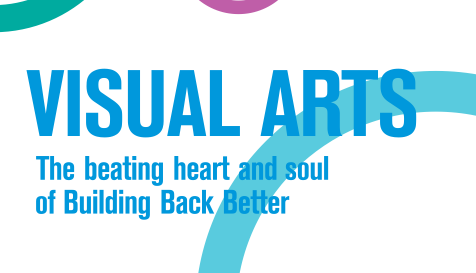Visual Arts: The beating heart and soul of building back better
15 December 2020 by Ed
Contemporary Visual Arts Network, and the APPG for Design & Innovation, we call for Government to exploit the potential of the Visual Arts sector to grow the economy following the Covid-19 pandemic, through explicit growth targets and rolling over existing tax incentives.

The first lockdown and social distancing measures introduced in response to Covid-19 have had a detrimental impact on the creative industries, with a projected £74bn turnover loss over the course of 2020. COVID is also expected to be responsible for 406,000 job losses for the sector – of which over two thirds to be self-employed.
In July, the Government announced a support package of £1.75bn for the creative industries which, while hugely beneficial in the short-term, is not sufficient on its own, and more direct support must be shown to the Visual Arts in order for the sector to survive. This report lays out five key recommendations to support the industry as we begin to move back into a tiered system following a second lockdown.
The first recommendation is to formally define the value of the Visual Arts sector, and to measure this value using Department of Culture, Media and Sports trade figures. This will involve establishing a group of visual arts specific Standard Occupational Classification (SOC) codes.
The report also recommends the Creative Industries Council take this baseline and use it to set an annual growth strategy and targets for the visual arts, and request the same to be done at a local level – this will help ensure the potential of the sector is understood and incentivised.
The third recommendation calls on the Government to extend and simplify the current tax incentives for small galleries and new artists to ensure that the social and economic benefits of culture are shared across the United Kingdom, and English regions, to support the Government’s levelling up agenda.
The report then recommends that visual artists should be designed into the detail of the government’s proposed ‘Global Talent’ immigration route, with a wide range of applicants able to be endorsed as ‘future leaders’ by the Arts Council, using the new Standard Occupational Classification codes developed out of our first recommendation.
Finally, the report recommends that in order to provide capacity for the existing network of galleries, local authorities, schools and universities to operate more effectively together and provide sector leadership, collaboration funding should be provided through the government to support delivery of the growth targets laid out in the second recommendation.
In implementing these recommendation, Government has an opportunity to build the visual arts sector back better, by taking into account the specific industry focussed challenges of the pandemic and ensuring that most appropriate support is given.
Jack Tindale, policy manager for design & innovation at Policy Connect and report author says:
“It has been an honour to work with CVAN and the visual arts sector on this report. After one of the most disruptive years in modern history, access to culture is more important than ever for our social and economic well-being. The recommendations we have set out in the report are ambitious, but necessary, and provide a clear roadmap for how artists can contribute to the economic recovery over the coming years”
Director of CVAN Paula Orrell says:
“Today marks a really important and significant step forward in formalising our relationship with government, something that has been a long time in the making. We are pleased to be in a position to be able to make these recommendations on behalf of our sector. We believe that the visual arts will play a pivotal role in this next, crucial, rebuilding phase.”
This report was commissioned by the Contemporary Visual Arts Network (CVAN) with partner support from a-n, The Artists Information Company.

